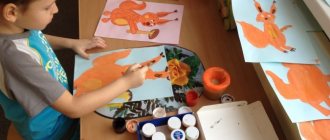Notes on drawing in the second junior group “My funny ringing ball.”
Summary of GCD for drawing in the second junior group
"My funny ringing ball."
Goal: to develop in children the ability to draw round objects with a continuous, continuous movement of the brush.
Tasks:
Educational: learn to close a line into a ring.
Developmental: develop aesthetic taste, the ability to navigate on a sheet of paper; develop fine motor skills and logical thinking.
Educational: to cultivate interest in drawing, to be careful with toys.
Materials and equipment: box, balls of different sizes and colors (balls according to the number of children in the group, basket with toys, easel, sheets of paper, gouache of different colors (like the colors of the balls, brushes, glasses of water, napkins)
.
Contents of organized children's activities
1. Organizational moment.
Educator. - Guys, look, guests have come to us. Let's say hello to them.
Children. - Hello!
Educator: - Well done guys, now sit down on the chairs
Educator. This morning at the door of our group
I found a large box
(The teacher puts the box on the table)
. I really want to know what lies there. What about you guys? To find out what is in the box, we must solve the riddle:
I can jump and roll,
And if they leave me, I’ll fly.
Laughing faces all around
Everyone is happy about the round... (Ball)
Educator. Well done guys, you solved the riddle. (The teacher opens the box and takes out the ball)
. But there is not only a ball, but also a surprise that you will find out at the end of the lesson. Therefore, you should try to complete tasks and actively answer questions.
What shape does the ball have? (Children's answers: round)
.
What size are the balls? (Children's answers: big and small)
What color are the balls? (Children's answers: red, green, blue)
2. Familiarity with the shape of the object.
Educator. The ball can also be made of plastic, which is hard, or rubber, which is soft. Can jump, jump, roll. But it must have a round shape. But here we have a basket of toys. All the toys were mixed up in it. Help me arrange the toys and take away the balls for yourself. (Each child receives a ball)
. Why do we need so many balls? What are we going to do with them? Let's remember how to play with the ball.
3. Exercises with the ball.
a) “Ball up, down”
- the initial position of the child is standing, legs slightly spread, holding a ball in his hands, lifts it up and then lowers it down.
b) “Ball forward, backward”
- the initial position of the child is standing, with his legs slightly spread, holding a ball in his hands, stretching it forward, and then pulling him towards himself.
c) “Ball in the basket”
— Children stand at the table and throw the ball into the basket.
4. Drawing “My funny, ringing ball”
.
Educator: What a wonderful toy! How interesting and fun it is to play with her! Look what beautiful balls we have - red, blue, yellow. But before starting any work, you need to prepare the tool. To draw, we need a landscape sheet, a brush, a glass of water, gouache of different colors, and napkins. But in order to draw beautifully, you need to hold the brush correctly in your hand, so that it is comfortable for both you and your assistant - the brush, with three fingers. And now we must first moisten this brush in water, remove excess water on the edge of the jar. Then you need to put a little paint on the brush, and also remove the excess on the edge of the jar. Now I can draw my ball, with smooth, continuous movements without lifting my brush, we draw a round ball.
The teacher on the easel shows techniques for drawing the shape of a ball.
Children draw pictures. The teacher controls the work methods and provides assistance to children experiencing difficulties.
Conclusion:
Educator: Well done, guys! Everyone drew very well, actively participated, and played with me. Thanks everyone! And we will hang your balls on the stand, and the guests who come to our group will admire them. Now let’s remember what we did in class; a surprise awaits you for the correct answers.
Reflection:
Educator: What did we learn to draw? (Children's answers: ball)
What shape does the ball have? (Children's answers: round)
What size are the balls? (Children's answers: big and small)
What color are the balls? (Children's answers: red, green, blue, yellow)
Tell me, who has the most beautiful ball? (Children's answers: children choose)
.
Our lesson has come to an end. Thank you for your attention.
How to draw a ball with a pencil step by step
Drawing a soccer ball step by step is actually quite easy. Draw an even circle with a pencil.
A soccer ball is made up of pentagons and hexagons. Draw a pentagon in the center of the already created circle. See the picture below.
Next, from each corner of the pentagon, draw lines of equal length. Use a ruler if you have difficulty determining the length of the lines by eye.
The following picture shows how to draw a soccer ball next. From the end point of the line, draw two lines in different directions. Try to keep them the same length too.
The same must be done for the remaining lines coming from the pentagon.
There is very little left in drawing this lesson. We close the lines - we get hexagons. Study the following drawing carefully. You should end up with one pentagon with hexagons around it.
Then finish the drawing with lines going to the base of the circle. The text may seem complicated, but the pictures will tell you more - they clearly show how to draw a soccer ball. Study them carefully, and you should not have any difficulties in drawing.
Soccer ball drawn! Color the pentagons black as in the main drawing of the lesson!
Pentagons
Draw pentagon shapes. Due to the round shape of the ball, pentagons throughout its entire surface visually look different from different angles.
All pieces must hit the same size. To do this, use a ruler.
Add lines to fully convey the “pattern” of the soccer ball.
5
OD summary on drawing on the topic “Colored balls” for children of the middle group.
Abstract of OD on drawing on
the topic “Colored balls
”
for children of the middle group.
Target:
teaching children the ability to depict round and oval objects.
Tasks:
1) continue to introduce children to the techniques of depicting round and oval objects; learn to convey in a drawing the distinctive features of round and oval shapes; strengthen painting skills; 2) develop hand motor skills and aesthetic taste.
3) cultivate the desire to achieve good results.
Materials:
a bunny toy, round and oval balloons, colored pencils, album sheets.
OD move:
1. Introductory part.
Psychological warm-up “All the children gathered in a circle.”
Educator:
Guys, today someone is in a hurry to visit us, and you will find out who when you guess my riddle:
In gloomy autumn it is gray, and in cold winter it is white. Who is this? Guess it! Well, of course, this is .... (Bunny)
Educator:
That's right, guys, this is Bunny. And here he is. Let's say hello. (Children greet the Bunny)
Educator
: Guys, today is Bunny’s birthday, he invited guests, set the table and began to decorate his house. The bunny wanted to inflate the balloons, but they all burst, leaving only two. So he came to you for help. What should I do, guys?
Children:
We need to help the Bunny.
Educator:
How can we help?
Children make guesses.
2. Main part.
Educator:
Well done boys! I suggest you help the Bunny. And to help him, you must learn to draw round and oval balls.
Educator:
Let's look at balloons
.
- Guys, what shape are the balls? (round, oval)
.
-What color can the balls be? To size?
Now I suggest you draw an oval shape in the air with the movement of your hand.
Educator:
Now I will show you a technique for drawing an oval-shaped ball
.
(The teacher shows the technique of drawing an oval with pencils
,
accompanying the words with the direction of movement:
“Round, long, round again and long again”
)
Educator:
Guys, maybe show someone at the blackboard how to draw an oval-shaped balloon
.
Finger game "Hide and Seek"
Educator:
We have stretched our fingers, and now we start drawing balls for the bunny.
Independent work of children,
The teacher helps individually, as needed.
After finishing the work, the teacher invites the children to attach the finished drawings to the magnetic board and turns to the little bunny: “Look, Bunny, what wonderful balls the guys have drawn for you .”
The bunny thanks the children for the balloons.
3.Final part.
Who's visiting today? Were we able to help Bunny? How?
On the topic: methodological developments, presentations and notes
Abstract of an integrated GCD on non-traditional drawing techniques. Middle group. Topic: “My funny ringing ball” Educational area - artistic creativity Goal: to teach children rice.
“My cheerful ringing ball” based on the poem by S.Ya. Marshak (team work).
- Consolidate knowledge of A. Barto’s poem “Ball”; - Learn to pronounce together the words of the game “My cheerful, ringing ball”; - Continue learning to paint over the outline of a drawing using a piece of foam sponge;-.
Goal: - To consolidate knowledge of A. Barto’s poem “Ball”; - To learn to pronounce together the words of the game “My cheerful, ringing ball”; - To continue to learn how to paint over the outline of a drawing with help.
Summary of a lesson on non-traditional drawing techniques in the second junior group Topic: “My funny ringing ball” Purpose: To introduce children to a new technique of non-traditional drawing techniques.
Source






